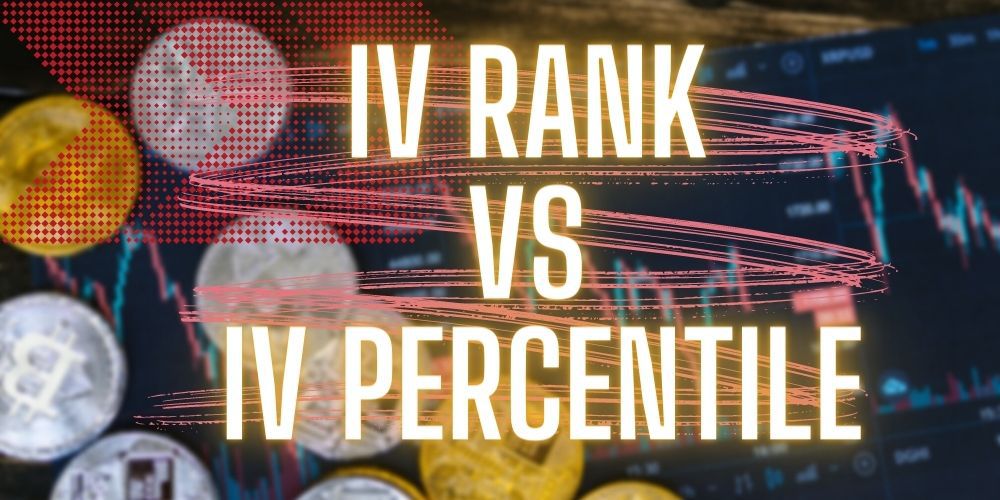Implied volatility is one of the most important parameters in option pricing. Two volatility metrics: IV rank and IV percentile, help understand the future value of IV so that traders can choose their options strategies correctly. This article will help you understand their differences.
What is the Difference Between IV Rank and IV Percentile?
IV rank tells where the implied volatility lies as opposed to its highest and lowest position in the previous year.
On the other hand, the IV percentile measures where the current implied volatility is positioned on its historical range during the same time period.
While both are useful for assessing implied volatility, there are differences between them.
The former compares current implied volatility to its highest and lowest point in the last year.

The latter tells how many days had a lower IV as opposed to today over those last 252 trading days.
While both offer insight into where the option premium is headed, the latter is considered a better metric in certain situations.
So where should we use IV rank, and where should we use IV percentile? We will cover this in the sections that follow.
But before we begin, let us start from the basics.
Implied Volatility
Implied volatility is the market’s assessment of how much a security’s price is likely to fluctuate.
In statistical terms, it is the projection of the movement in value during the year for an underlying stock on a single standard deviation (SD).
The options pricing formula (Black-Scholes) is used to derive IV.
Let us explain this with some numbers.
A share XYZ sells at $50 but has an implied volatility of 30%.
It means there is a probability that its price will move between $35 to $55 during the year.
Since the measure is applicable only within one standard deviation, the likelihood of the above statement coming true is 68.2%.
The thing to keep in mind is that it’s a probability – it is not 100% accurate.

However, while it is not a perfect measure, it does give a good indication of how much a security is likely to fluctuate in price.
The primary use of this metric is in trading options. IV lets traders judge the future value of their contracts.
Those shares for whom it is high will have a bigger premium, and the reverse also holds.
But in itself, it is impossible to judge whether implied volatility is greater or lesser.
This is because specific sectors and stocks inherently have more price fluctuations than others.
Keeping an objective cutoff between low and high IVs that holds true for all securities is difficult.
Therefore, IV rank and IV percentile are created to solve this issue.
What Does IV Rank Tell You?
The implied volatility rank (IVR) is a metric that compares the current IV with the previous 52 weeks’ trading data.
It ranks the level at the moment on a scale between 0 to 100, with the former being the lowest and the latter being the highest.
IVR tells you how the current IV stands in terms of the biggest and smallest it has been in the last year.
A very low value shows it has nearly bottomed out, whereas the other end of the spectrum indicates that it is approaching the maximum.
IV itself is a measure of how much the market expects a securities price to move.
But on its own, the number is subjective. It is challenging to assign whether it is good or bad.
With this measure, the problem is resolved.
A high rank tells options traders that there is a good time to sell because the option price is at a peak, whereas when it is low, the reverse is true.
What Does IV Percentile Tell You?
The implied volatility percentile (IVP) measures the number of days in the past year when the IV was lower than its current value.
In a way, it tells where the most recent level ranks between all previous ones over 252 trading days.
A high implied volatility indicates that the current level is not optimal for buying because options would be priced high.
In fact, sellers might be having a good time right now.
The reverse is true when IVP goes down.
How To Calculate IV Percentile
IV percentiles can easily be calculated when trading data for each day of the year is available.
First, find out how many of these had a lower value of IV% as opposed to the current one.

Once this is done, divide it by 252 (average trading days per year) to get the stock’s IV percentile.
For example, if there were 96 such days, the calculation would yield the metric to be 96/252 = 38.
What is a Good IV Percentile?
A high value is usually anything above 80, while a low would be under 20.
Whether it is good or bad depends on the trading strategy.
A small value for IVP indicates low volatility. In such scenarios, options would be priced lower.
This is because if price fluctuations are fewer, it is less likely that the contract would become in the money.
Hence it is an opportune time to buy.
On the other hand, a large value usually indicates that there is a greater chance of price movements in the underlying stock.
Hence, the possibility of becoming profitable in the option has grown.
It causes the premiums to rise, making it a good time for sellers.
How to Calculate IV Rank
First, determine the previous year’s highest and lowest implied volatility values.
Once this data is available, the calculation of IV Rank is as follows:
(Current IV% – Lowest IV%) / (Highest IV% – Lowest IV%)
As a simple example, let us say the recent IV was 50%, which has remained between 20% to 80% in the previous year.
Then the IVR = (50-20) / (80-20) = 0.5 (or 50%)
What is a Good IV Rank?
50% is the usual threshold that traders use to decide whether it is high or low.
A bigger value indicates more volatility, hence a better possibility for the option to be profitable.

This increases their price, making it a good time to sell options.
On the other hand, a lower number indicates it might be opportune to buy instead.
Both IV rank and IV percentile are measures for the same thing.
IV Rank over 100 or less than 0
Based on the formula presented, traders might believe that IV Rank can never go below 0 or above 100.
However, practically this is not true.
When the current IV becomes either more than the previous high or lesser than the low, the rank parameter can take extraordinary values.
In either case, the anomaly only lasts for a session.
It suggests to traders that a new IV level is being discovered, and they should plan their trades accordingly.
Is IV Rank or IV Percentile More Accurate?
Generally speaking, implied volatility percentile and rank tell how the IV moves for a particular asset.
However, this indicator is more nuanced since it considers movements in the implied volatility on each day of the year.
It checks the current IV against every one of the previous 252 days, and figures out how many of them had a lower IV.
In contrast, the IVR value just compares the IV at present to its peak and trough.
Due to its dependence only on two data points, it does not handle outliers very well.
For example, let us shorten the trading period in a year to just ten days when the IV values were as follows:
- 20%
- 22%
- 24%
- 26%
- 28%
- 60%
- 20%
- 18%
- 20%
- 22%
Notice that the high value is extremely different from what it is typically (usually, IV hovers between 18% – 28%).
Assuming that the current IV is at 23% (in the middle of the range).
Ideally, the two metrics should indicate this to be an average value.
However, when we plug the numbers into the formula:
IV rank = (23% – 18%) / (60%- 18%) = 12%
Surprisingly, the result seems to say that the IV is particularly low right now (even though visual inspection shows this is not true).
Next, let us see what the other metric tells us.
The number of days when historical values are lower than current IV = 6, and total trading days (in this example) is 10.
Hence IV Percentile = 6/10 =60%.
It correctly shows that the recent IV is slightly more than the average.
Hence, traders often tend to prefer this one over the other as a truer indicator of the current position.
Final Words
Understanding expected volatility is critical in options trading.
While stock price movement is difficult to predict, knowing that there is a higher chance of fluctuations helps decide the right strategy.
But implied volatility in itself is an incomplete measure.
There is no objective frame of reference to compare it to, so using it alone is impossible.
IV rank and IV percentile serve this purpose effectively.
These metrics indicate how the expected volatility will move with respect to how it has performed in the previous trading year.
The former tells traders how big or small the number is against its high and low peaks.
The IV percentile counts how many days had an IV lower than what it is now.
Due to its inclusion of several data points in the calculation, this metric offers a more reliable picture.
In cases when there were unusual spikes in IV during the year, the percentile value continues to provide a more realistic picture.


 Tags:
Tags:










